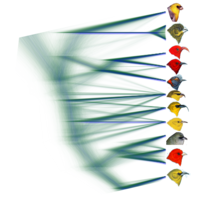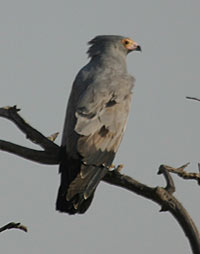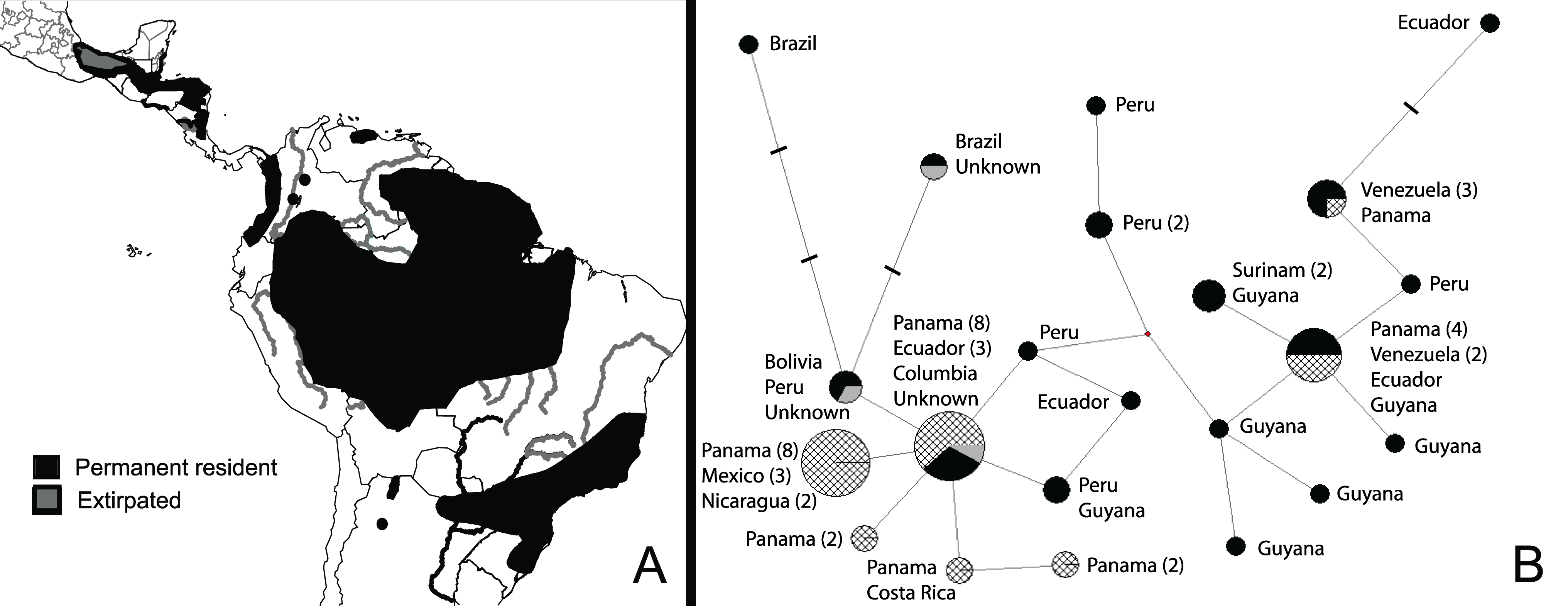Current Projects
Where did all these species come from and will they survive into the future?
Museum collections hold a treasure trove of information, from genetic to environmental. I use these collections in my scientific research to explore how genotype, phenotype and the environment interact to affect the evolution and persistence of species through time. Previous projects have explored the rate and drivers of speciation in raptors and mammals, including extinct species like the Giant Eagle of Middle Earth and the Giant Beaver. In 2019, I began a collaboration with Dr. Alice Boyle investigating behavioral and physiological responses to rainfall variation in Grasshopper Sparrows at Konza Prairie in Kansas.Weather impacts on songbird populations
Immigration and emigration via dispersal can be a major driver of population dynamics of mobile animals, yet these key demographic rates remain challenging to estimate for most taxa. In the Great Plains of North America, the tremendous inter-annual variability in rainfall likely shapes dispersal propensity of grassland-dependent songbirds, but the nature of such responses has not been elucidated. We are utilizing biochemical assays of feathers from Grasshopper Sparrows that have bred at the Konza Prairie over six years to understand behavioral and physiological responses to interannual variation in rainfall. The project aims to determine the (1) degree of inter-annual variability in local isotopic signatures, (2) degree of isotopic variation due to climate vs. vegetation composition, (3) relationship between growing season rainfall and dispersal, and (4) contribution of precipitation conditions to corticosterone deposited in feathers and subsequent dispersal.
This project will contribute important data needed to understand how climate influences dispersal behavior in a guild of threatened grassland birds. We aim to advance our understanding of the drivers of population dynamics in open, variable systems, particularly the relative magnitude of direct and indirect climatic effects on population dynamics. This project will also address the assumptions underlying inferences related to the use of feather isotopes, laying the groundwork for future projects on site fidelity and environmental variation over larger temporal scales.
How do museums (and other informal STEM learning sites) support communities and social change?
My social science research addresses the role of informal STEM learning institutions in advancing social good. I am currently working with Knology (formerly New Knowledge) to gain a better understanding of the people who visit informal STEM learning institutions and how such institutions can better support and connect with their communities, especially to promote larger societal endeavors. Check out the WZAM site for announcements about the results of this research.
Previous Projects
Neutral sites
Phylogenetic and Population/Conservation Genetics Research
Species relationships (i.e. phylogenies) are the foundation of modern methods in evolution. They provide a framework for studying the evolution of behavioral and morphological traits and patterns of speciation and extinction. Furthermore, molecular phylogenetic methods are useful in identifying distinct groups (e.g. species) that may be priorities for species conservation. Similarly, population-level (rather than species-level) data are essential for understanding the process of speciation as well as for preserving genetic diversity in species at risk of extinction. In my research, I investigate patterns and processes of avian speciation using phylogenetic and population genetic methods to analyze molecular and morphological data.
In my current and previous research I have established well-supported phylogenies for two very different avian groups: the Accipitridae (raptors) and the Drepanidinae (Hawaiian Honeycreepers). I chose these groups because of their extraordinary diversity, which allows me to test a multitude of hypotheses about life history evolution and biogeography within a phylogenetic context. These projects are described briefly below, including conservation implications from the Accipitridae work. I am also currently working on a phylogeny for crows, specifically investigating island speciation processes in these cosmopolitan and intelligent birds.
Phylogeny and Comparative Evolutionary Rates in the Hawaiian Honeycreeper Radiation from Pyrosequencing

The process of adaptive radiation has played a central role in the development of theories regarding speciation and adaptation. The Hawaiian honeycreepers are a classic example of adaptive radiation, encompassing tremendous diversity in morphology, ecology and behavior. Their highly divergent morphologies (see photo), particularly evident in traits related to feeding, are reminiscent of parrots, finches and nectar-feeding groups.
The rapidity of the honeycreeper radiation, low sequence divergence and substantial extinction (23 of the 56 known species are extinct) have hindered efforts to reconstruct their evolutionary history. Without a well-resolved phylogeny, little can be gained from this otherwise ideal study system. Previous molecular phylogenies lacked resolution, raising doubt about the tractability of phylogenetic reconstruction in this group. Thus, I turned to next-generation sequencing methods to obtain genomic-level sampling for the honeycreepers (whole mitiochondrial genomes and 13 nuclear loci).
Theoretical and simulation studies show that the evolutionary relationships within many recent radiations may never be resolved with DNA sequence data due to the strong effects of mutational variance on recent divergences. To account for the recency of the radiation and coalescent process, I used a newly developed method to jointly estimate the gene trees and species tree for the Hawaiian honeycreeper radiation and relatives.
These data and methods have provided the first well-resolved and well-supported phylogeny for the extant Hawaiian honeycreepers, allowing me to calibrate rates of evolution, evaluate the role of island formation in speciation and identify the honeycreepers' closest cardueline relatives. This research, published in Current Biology (cover feature) is an F1000 reviewed article.
Raptor Phylogenetics (Accipitridae)

Eagles, hawks, kites, Old World vultures, accipiters and goshawks comprise the avian Accipitridae family (~231 species). They are predominantly predatory birds, taking other birds or small to medium mammals as prey, although several taxa scavenge carrion or eat a moderate amount of fruit in their diet. All Accipitridae species are protected under the Convention on International Trade in Endangered Species (CITES) and four eagles are listed as top priority species. As ecologically sensitive predators, birds of prey are valuable indicators of habitat quality.
Historically, phylogeny for raptors in the family Accipitridae was based on morphological traits and was difficult to resolve, due at least in part to extensive convergence in traits related to shared predatory lifestyles and high morphological plasticity in this group. I collected tissue and feather samples for over 200 raptors in South America and Africa. With the use of existing museum specimens, I included representatives of all 14 Accipitridae subfamilies, all but two genera and nearly all known species (>85%) in my analyses.
Multiple well-supported relationships among accipitrids identified with my dataset differ from those traditionally recognized based on morphology or life history traits. For example, harpy eagles (Harpiinae), snake eagles (Circaetinae), kites, accipiters and Old World vultures were all found to be non-monophyletic groupings (Lerner and Mindell 2005). Two species with highly specialized limb morphology enabling predation on cavity-nesting species (the gymnogene, Polyboroides typus [see photo]; and the Crane Hawk, Geranospiza caerulescens) were found not to be close relatives, an example of convergent evolution that also highlights the morphological plasticity in the Accipitridae. The inclusion of multiple samples at the subspecies level identified several species that are non-monophyletic or contain high levels of genetic diversity forming two or more reciprocally monophyletic groups (e.g. Hieraaetus fasciatus, H. morphnoides and Leucopternis albicollis, Gyps indicus; Lerner et al 2008, Johnson et al. 2006, Lerner and Mindell 2005). In several cases these findings have important conservation implications as one or more taxa are threatened with extinction.
The results of this research will be highly useful throughout my career as they establish a well-supported molecular phylogeny against which many hypotheses relating to the evolution of Accipitridae can be tested. In the near future I am particularly interested in assessing the timing of divergence events and the general biogeographic history of the group.
Conservation genetics of harpy eagles (Harpia harpyja) and white hawks (Leucopternis spp.)
The harpy eagle (Harpia harpyja) is a large predatory bird of lowland forests historically ranging from southern Mexico to Argentina and Brazil. Wild harpy eagle populations have been in decline for some time and have been extirpated from much of their historic range, particularly in Central America. Geographic patterns of genetic relatedness in extant and historic populations can provide critical data to conservation efforts that aim to maximize genetic diversity for the health of captive and wild populations. Furthermore, the broad distribution of harpy eagles on opposite sites of the Andean cordillera make it an appropriate candidate for studying the effects of vicariance events such as habitat fragmentation due to Andean orogeny, aridity during glacial maxima, and sea level rises during the Cenozoic. This component of my research found high levels of genetic diversity in combination with genetic differentiation among subgroups of harpy eagles, highlighting the importance of local population conservation in order to preserve maximal levels of genetic diversity and evolutionary processes of restricted gene flow. Restricted female-mediated gene flow is an important consideration for captive-breeding programs and while conducting this research I partnered with The Peregrine Fund, a non-profit conservation organization conducting captive-breeding of harpy eagles.

Harpy eagle geographic distribution (A) and median-joining network (B) depicting relationships among control region haplotypes from harpy eagles sampled in South America (black), Central America (hatched) and three individuals of unknown origin (grey). Circle size is proportional to the number of individuals. (Lerner et al. 2008)
In my continuing research, I am evaluating levels of genetic diversity in other raptors of conservation concern, particularly Neotropical taxa. Neotropical rainforests contain the greatest avian biodiversity of all the biomes in the world with some of the highest rates of extinction. Elucidating the mechanisms that have led to such high diversification is a significant area of research in evolutionary biology. Yet, most studies have had minimal data to test for correspondence between geologic or climatic events, environmental stability and species divergences. I have collected samples of three closely related Neotropical white hawk taxa. Two of the white hawk taxa are of conservation concern (the mantled hawk and the gray-backed hawk), yet it is unclear whether they satisfy the strict sense of the biological species concept which requires a lack of gene flow among sister species.
With the use of DNA sequence data, I will evaluate levels of gene flow within the white hawk taxa while addressing fundamental questions about biodiversity. These data will allow me to distinguish among hypotheses of Neotropical diversification that make specific predictions about genealogy, effective population size, historical migration levels, directions of migration, and timing of diversifications (e.g. habitat fragmentation due to Andean uplift, aridity during glacial maxima, and changes in sea level). These questions have never before been addressed using birds of prey and have only minimally been addressed in other avian taxa.
Neutral sites
Phylogenetic and Population/Conservation Genetics Research
Species relationships (i.e. phylogenies) are the foundation of modern methods in evolution. They provide a framework for studying the evolution of behavioral and morphological traits and patterns of speciation and extinction. Furthermore, molecular phylogenetic methods are useful in identifying distinct groups (e.g. species) that may be priorities for species conservation. Similarly, population-level (rather than species-level) data are essential for understanding the process of speciation as well as for preserving genetic diversity in species at risk of extinction. In my research, I investigate patterns and processes of avian speciation using phylogenetic and population genetic methods to analyze molecular and morphological data.
In my current and previous research I have established well-supported phylogenies for two very different avian groups: the Accipitridae (raptors) and the Drepanidinae (Hawaiian Honeycreepers). I chose these groups because of their extraordinary diversity, which allows me to test a multitude of hypotheses about life history evolution and biogeography within a phylogenetic context. These projects are described briefly below, including conservation implications from the Accipitridae work. I am also currently working on a phylogeny for crows, specifically investigating island speciation processes in these cosmopolitan and intelligent birds.
Phylogeny and Comparative Evolutionary Rates in the Hawaiian Honeycreeper Radiation from Pyrosequencing

The process of adaptive radiation has played a central role in the development of theories regarding speciation and adaptation. The Hawaiian honeycreepers are a classic example of adaptive radiation, encompassing tremendous diversity in morphology, ecology and behavior. Their highly divergent morphologies (see photo), particularly evident in traits related to feeding, are reminiscent of parrots, finches and nectar-feeding groups.
The rapidity of the honeycreeper radiation, low sequence divergence and substantial extinction (23 of the 56 known species are extinct) have hindered efforts to reconstruct their evolutionary history. Without a well-resolved phylogeny, little can be gained from this otherwise ideal study system. Previous molecular phylogenies lacked resolution, raising doubt about the tractability of phylogenetic reconstruction in this group. Thus, I turned to next-generation sequencing methods to obtain genomic-level sampling for the honeycreepers (whole mitiochondrial genomes and 13 nuclear loci).
Theoretical and simulation studies show that the evolutionary relationships within many recent radiations may never be resolved with DNA sequence data due to the strong effects of mutational variance on recent divergences. To account for the recency of the radiation and coalescent process, I used a newly developed method to jointly estimate the gene trees and species tree for the Hawaiian honeycreeper radiation and relatives.
These data and methods have provided the first well-resolved and well-supported phylogeny for the extant Hawaiian honeycreepers, allowing me to calibrate rates of evolution, evaluate the role of island formation in speciation and identify the honeycreepers' closest cardueline relatives. This research, published in Current Biology (cover feature) is an F1000 reviewed article.
Raptor Phylogenetics (Accipitridae)

Eagles, hawks, kites, Old World vultures, accipiters and goshawks comprise the avian Accipitridae family (~231 species). They are predominantly predatory birds, taking other birds or small to medium mammals as prey, although several taxa scavenge carrion or eat a moderate amount of fruit in their diet. All Accipitridae species are protected under the Convention on International Trade in Endangered Species (CITES) and four eagles are listed as top priority species. As ecologically sensitive predators, birds of prey are valuable indicators of habitat quality.
Historically, phylogeny for raptors in the family Accipitridae was based on morphological traits and was difficult to resolve, due at least in part to extensive convergence in traits related to shared predatory lifestyles and high morphological plasticity in this group. I collected tissue and feather samples for over 200 raptors in South America and Africa. With the use of existing museum specimens, I included representatives of all 14 Accipitridae subfamilies, all but two genera and nearly all known species (>85%) in my analyses.
Multiple well-supported relationships among accipitrids identified with my dataset differ from those traditionally recognized based on morphology or life history traits. For example, harpy eagles (Harpiinae), snake eagles (Circaetinae), kites, accipiters and Old World vultures were all found to be non-monophyletic groupings (Lerner and Mindell 2005). Two species with highly specialized limb morphology enabling predation on cavity-nesting species (the gymnogene, Polyboroides typus [see photo]; and the Crane Hawk, Geranospiza caerulescens) were found not to be close relatives, an example of convergent evolution that also highlights the morphological plasticity in the Accipitridae. The inclusion of multiple samples at the subspecies level identified several species that are non-monophyletic or contain high levels of genetic diversity forming two or more reciprocally monophyletic groups (e.g. Hieraaetus fasciatus, H. morphnoides and Leucopternis albicollis, Gyps indicus; Lerner et al 2008, Johnson et al. 2006, Lerner and Mindell 2005). In several cases these findings have important conservation implications as one or more taxa are threatened with extinction.
The results of this research will be highly useful throughout my career as they establish a well-supported molecular phylogeny against which many hypotheses relating to the evolution of Accipitridae can be tested. In the near future I am particularly interested in assessing the timing of divergence events and the general biogeographic history of the group.
Conservation genetics of harpy eagles (Harpia harpyja) and white hawks (Leucopternis spp.)
The harpy eagle (Harpia harpyja) is a large predatory bird of lowland forests historically ranging from southern Mexico to Argentina and Brazil. Wild harpy eagle populations have been in decline for some time and have been extirpated from much of their historic range, particularly in Central America. Geographic patterns of genetic relatedness in extant and historic populations can provide critical data to conservation efforts that aim to maximize genetic diversity for the health of captive and wild populations. Furthermore, the broad distribution of harpy eagles on opposite sites of the Andean cordillera make it an appropriate candidate for studying the effects of vicariance events such as habitat fragmentation due to Andean orogeny, aridity during glacial maxima, and sea level rises during the Cenozoic. This component of my research found high levels of genetic diversity in combination with genetic differentiation among subgroups of harpy eagles, highlighting the importance of local population conservation in order to preserve maximal levels of genetic diversity and evolutionary processes of restricted gene flow. Restricted female-mediated gene flow is an important consideration for captive-breeding programs and while conducting this research I partnered with The Peregrine Fund, a non-profit conservation organization conducting captive-breeding of harpy eagles.

Harpy eagle geographic distribution (A) and median-joining network (B) depicting relationships among control region haplotypes from harpy eagles sampled in South America (black), Central America (hatched) and three individuals of unknown origin (grey). Circle size is proportional to the number of individuals. (Lerner et al. 2008)
In my continuing research, I am evaluating levels of genetic diversity in other raptors of conservation concern, particularly Neotropical taxa. Neotropical rainforests contain the greatest avian biodiversity of all the biomes in the world with some of the highest rates of extinction. Elucidating the mechanisms that have led to such high diversification is a significant area of research in evolutionary biology. Yet, most studies have had minimal data to test for correspondence between geologic or climatic events, environmental stability and species divergences. I have collected samples of three closely related Neotropical white hawk taxa. Two of the white hawk taxa are of conservation concern (the mantled hawk and the gray-backed hawk), yet it is unclear whether they satisfy the strict sense of the biological species concept which requires a lack of gene flow among sister species.
With the use of DNA sequence data, I will evaluate levels of gene flow within the white hawk taxa while addressing fundamental questions about biodiversity. These data will allow me to distinguish among hypotheses of Neotropical diversification that make specific predictions about genealogy, effective population size, historical migration levels, directions of migration, and timing of diversifications (e.g. habitat fragmentation due to Andean uplift, aridity during glacial maxima, and changes in sea level). These questions have never before been addressed using birds of prey and have only minimally been addressed in other avian taxa.
